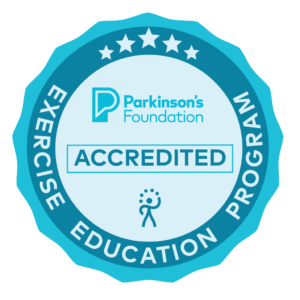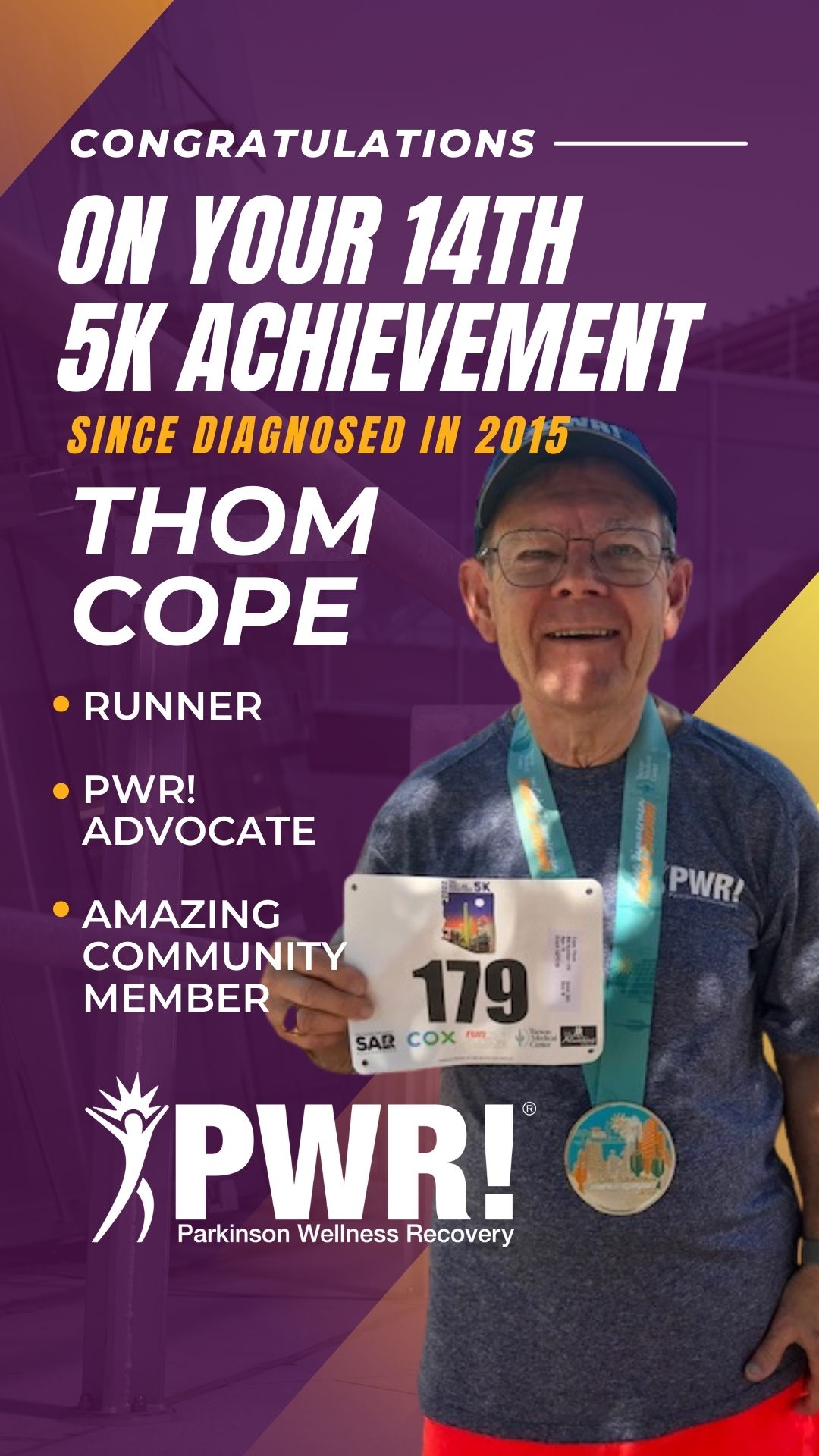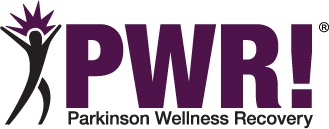Let's Train Person's with Parkinson Disease Like Athletes
The Parkinson’s Foundation and the American College of Sports Medicine (ACSM) announced new exercise recommendations for Parkinson’s disease on May 25, 2021.
The new guidelines adhere to the traditional method of prescribing exercise using the FITT method: an acronym for frequency, intensity, time and type (of exercise). They focus on multiple domains of fitness: aerobics, strength, balance/agility/multi-tasking and flexibility.
PWR! is proud to be recognized as a Parkinson Foundation Accredited Exercise Education Program.
We are now training community exercise professionals in how to design and implement Parkinson-specific exercise classes that are safe and effective. Instead of teaching general activities for each fitness domain, with the hope it transfers to better physical functioning, we are teaching exercise professionals to train People with Parkinson's like functional athletes, to improve multiple domains of fitness, symptoms and participation in life!

In the sections below, we describe how our PWR!Moves exercise curriculum, designed to re-train and sustain functional mobility, shares many similarities with open skill exercise design, typically used in sports. We propose these similarities allow for achieving the optimal specificity and intensity to train PWP to be functional athletes!
Open versus Closed Skill Exercise
Open skill sports require players to perform in dynamically changing, unpredictable, and externally paced environments (e.g., table tennis, tennis, squash, basketball, martial arts, fencing). In contrast, closed skill sports require players to follow set patterns in a relatively stable and predictable environment and are more self-paced (e.g., running, swimming, golf)2. From a coaching perspective, there are fundamental skills that must be mastered in all sports, however, open skill sports are better trained in variable practice conditions, while closed skill sports are better trained in fixed practice conditions3. Interestingly, athletes that participate in open skill sports demonstrate better executive function (inhibition, conflict resolution, flexibility) than their peers that participate in closed skill sports4,5.
The fundamentals of our PWR!Moves curriculum are clinically relevant to Parkinson disease (PD) pathophysiology
Just as for all athletes, there are fundamental skills that deteriorate in PD that must be mastered before highly skilled real-world movements can be accomplished with quality and efficiency. What makes our “sports” program different from other exercise programs for PwP is that the fundamental skills (i.e., PWR!Moves) are theoretically designed to provide the specificity of training that is clinically relevant to the management of PD symptoms, functional decline and loss of mobility. PWR!Moves are highly automated skills that underlie complex movements. They are dependent upon dopamine circuits for their realization.
Training starts with blocked practice of the Fundamentals
According to our PWR!Moves curriculum, PD-specialized therapists and exercise professionals start by retraining the fundamental “building blocks of function” under mass practice conditions (i.e., high effort, high repetition) in relatively stable and predictable environments. This type of high-intensity practice addresses sports science and neuroscience principles of specificity, use it or lose it; use it and improve it, and overload6,7. Even if individuals with PD self-report that everyday movements are not compromised, the intentional rehearsal of fundamental skills may re-train sensory motor awareness of what good movement quality feels and looks like so that everyday movements are maintained longer or don’t deteriorate8-9.

Specificity and overload are not enough for restoring complex movements
Research shows that people get better under task- and context specific massed practice conditions10. However, this type of practice may not be adequate to restore damaged circuits that are typically involved in complex behaviors11. This may explain why PWP don’t transfer fundamental skills or trained tasks to everyday movements10. Recent studies suggest that the principle of progressive exercise is necessary to achieve “transfer” of a skill to more than one situation or context12-13. This type of practice has also been shown to underlie physiological and structural brain function in PWP13.
In our PWR!Moves curriculum, we implement progressive exercise.
As quality of the movement fundamentals and “vigor” improves, the fundamentals are progressed from part to whole, from fixed to variable practice conditions. This is similar to the open skill variable practice conditions in sports. For example, we increase the complexity of movements under dynamic conditions by varying movement pattern sequences, positions, directions and environmental context while also challenging executive function requirements (i.e., working memory, predictability, attention, visual -spatial, problem-solving)14. Practice becomes not only more complex, but mimics meaningful real-world challenges required for everyday movements.
Interestingly, research suggests that there is no one best exercise or “sport” approach for PWP. Instead, multiple activities or sports that adhere to these open sports principles of practice have been shown to benefit PWP15. We propose that the more an approach targets PD symptoms and the underlying impairments contributing to functional decline and loss of mobility in open skill conditions, the more benefits PWP may experience. That is what makes PWR!Moves exercise programs different from other “open skill” programs for PWP.
Go train functional mobility as an “open sport” – Train PWP like athletes!
Our methods of training are theoretically designed from the beginning to target multiple symptoms of PD, focus on part to whole functional mobility training and to implement progressive exercise methods to challenge real life physical and executive function challenges14.
Dr. Becky Farley About the Author
If you ask her, Dr. Becky Farley will tell you that working with her first client with Parkinson’s almost 20 years ago changed her life and her career, and since then she hasn't stopped changing lives of those living with Parkinson's, in Arizona and the rest of the world. In 2010, she established the PWR!Gym in Tucson and has been offering people with Parkinson disease the PD-specific physical therapy, group exercise, and social engagement they need to get better and stay better. Globally, Dr. Farley supports PWR!’s mission of making cutting-edge PD-specific "exercise as medicine” available to the 10 million people living with PD worldwide, by training healthcare and fitness professionals in the PWR!Moves and the PWR!4Life model (and she’s trained over 6000 professionals since she started in 2010!).
When she’s home in Arizona, you’ll find Becky working on Parkinson Disease-specific exercise at the PWR!Gym as well as leading our annual exercise intensive PWR! Retreats. When she’s on the road, she’s either teaching our PWR!Moves workshops or giving talks at conferences, community organizations, and healthcare networks across the US and world.
When she isn’t working, you can find her working out, walking the dog, and gardening. To learn even more about Dr. Farley, visit our team page.

Resources
- Learn more about our exercise accreditation by visiting: https://www.parkinson.org/resources-support/professionals/resources/exercise-professionals
- GALLIGAN, F. et al. (2000) Acquiring Skill In: GALLIGAN, F. et al., Advanced PE for Edexcel. 1st ed. Bath: Bath Press, p. 102-108
- DAVIS, B. et al. (2000) The Nature and classification of skill. In: DAVIS, B. et al. Physical Education and the study of sport. 4th ed. London: Harcourt Publishers, p. 284-285
- Gu Q, Zou L, Loprinzi PD, Quan M, Huang T. Effects of Open Versus Closed Skill Exercise on Cognitive Function: A Systematic Review. Front Psychol. 2019;10:1707. Published 2019 Jul 27. doi:10.3389/fpsyg.2019.01707
- Wang CH, Chang CC, Liang YM, et al. Open vs. closed skill sports and the modulation of inhibitory control. PLoS One. 2013;8(2):e55773. doi:10.1371/journal.pone.0055773
- Kleim JA, Jones TA. Principles of Experience-Dependent Neural Plasticity: Implications for Rehabilitation After Brain Damage. J Speech Lang Hear Res. 2008;51(1):S225. doi:10.1044/1092-4388(2008/018)
- Bouça-Machado R, Venturelli M, Tinazzi M, Schena F, Ferreira JJ. Treating Patients Like Athletes: Sports Science Applied to Parkinson's Disease. Front Neurol. 2020;11:228. Published 2020 Apr 2. doi:10.3389/fneur.2020.00228
- Wulf G, Lewthwaite R. Optimizing performance through intrinsic motivation and attention for learning: The OPTIMAL theory of motor learning. Psychon Bull Rev. 2016;23(5):1382-1414. doi:10.3758/s13423-015-0999-9
- Marinelli L, Quartarone A, Hallett M, Frazzitta G, Ghilardi MF. The many facets of motor learning and their relevance for Parkinson's disease. Clin Neurophysiol. 2017;128(7):1127-1141. doi:10.1016/j.clinph.2017.03.042
- Hondzinski JM. Specificity of Training, Not the Only Therapy Option for Parkinson’s Patients. J Nov Physiother. 2012;02(06):10-11. doi:10.4172/2165-7025.1000e119
- Petzinger GM, Fisher BE, McEwen S, Beeler JA, Walsh JP, Jakowec MW. Exercise-enhanced neuroplasticity targeting motor and cognitive circuitry in Parkinson’s disease. Lancet Neurol. 2013;12(7):716-726. doi:10.1016/S1474-4422(13)70123-6
- Onla-Or S, Winstein CJ. Determining the optimal challenge point for motor skill learning in adults with moderately severe Parkinson’s disease. Neurorehabil Neural Repair. 2008;22(4):385-395. doi:10.1177/1545968307313508
- Patel R, Spreng RN, Turner GR. Functional Brain Changes Following Cognitive and Motor Skills Training. Neurorehabil Neural Repair. 2013;27(3):187-199, doi:10.1177/1545968312461718
- Mahajan A, Deal JA, Carlson M. Interventions in Parkinson's disease: Role of executive function. Front Biosci (Landmark Ed). 2017;22(3):416-427. Published 2017 Jan 1. doi:10.2741/4492
- Hao Z, Zhang X, Chen P. Effects of Ten Different Exercise Interventions on Motor Function in Parkinson’s Disease Patients—A Network Meta-Analysis of Randomized Controlled Trials. Brain Sci. 2022;12(6):698. doi:10.3390/brainsci12060698
